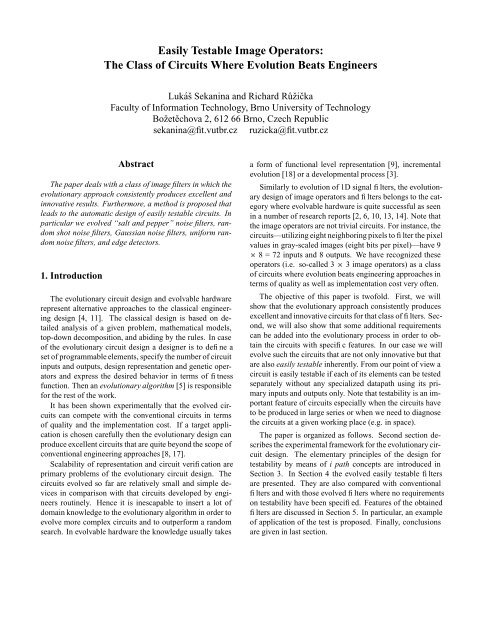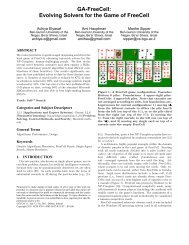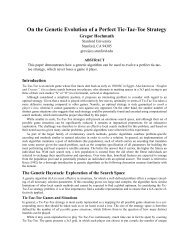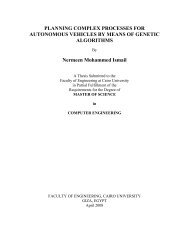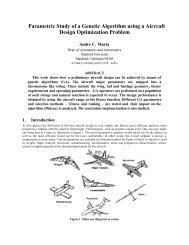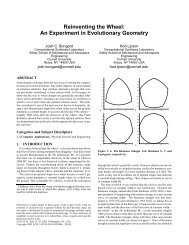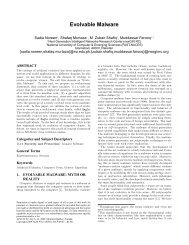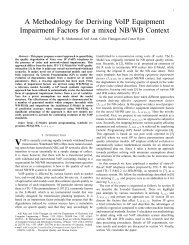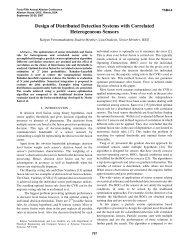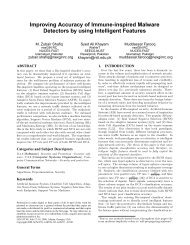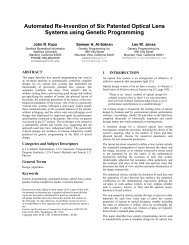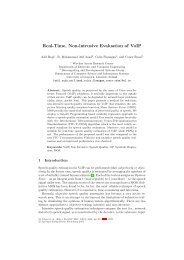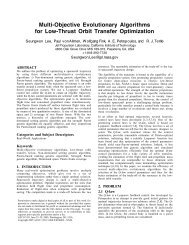Novel image filters implemented in hardware - Genetic ...
Novel image filters implemented in hardware - Genetic ...
Novel image filters implemented in hardware - Genetic ...
You also want an ePaper? Increase the reach of your titles
YUMPU automatically turns print PDFs into web optimized ePapers that Google loves.
Easily Testable Image Operators:<br />
The Class of Circuits Where Evolution Beats Eng<strong>in</strong>eers<br />
Lukáš Sekan<strong>in</strong>a and Richard Růžička<br />
Faculty of Information Technology, Brno University of Technology<br />
Božetěchova 2, 612 66 Brno, Czech Republic<br />
sekan<strong>in</strong>a@fit.vutbr.cz ruzicka@fit.vutbr.cz<br />
Abstract<br />
The paper deals with a class of <strong>image</strong> <strong>filters</strong> <strong>in</strong> which the<br />
evolutionary approach consistently produces excellent and<br />
<strong>in</strong>novative results. Furthermore, a method is proposed that<br />
leads to the automatic design of easily testable circuits. In<br />
particular we evolved “salt and pepper” noise <strong>filters</strong>, random<br />
shot noise <strong>filters</strong>, Gaussian noise <strong>filters</strong>, uniform random<br />
noise <strong>filters</strong>, and edge detectors.<br />
1. Introduction<br />
The evolutionary circuit design and evolvable <strong>hardware</strong><br />
represent alternative approaches to the classical eng<strong>in</strong>eer<strong>in</strong>g<br />
design [4, 11]. The classical design is based on detailed<br />
analysis of a given problem, mathematical models,<br />
top-down decomposition, and abid<strong>in</strong>g by the rules. In case<br />
of the evolutionary circuit design a designer is to def<strong>in</strong>e a<br />
set of programmable elements, specify the number of circuit<br />
<strong>in</strong>puts and outputs, design representation and genetic operators<br />
and express the desired behavior <strong>in</strong> terms of fitness<br />
function. Then an evolutionary algorithm [5] is responsible<br />
for the rest of the work.<br />
It has been shown experimentally that the evolved circuits<br />
can compete with the conventional circuits <strong>in</strong> terms<br />
of quality and the implementation cost. If a target application<br />
is chosen carefully then the evolutionary design can<br />
produce excellent circuits that are quite beyond the scope of<br />
conventional eng<strong>in</strong>eer<strong>in</strong>g approaches [8, 17].<br />
Scalability of representation and circuit verification are<br />
primary problems of the evolutionary circuit design. The<br />
circuits evolved so far are relatively small and simple devices<br />
<strong>in</strong> comparison with that circuits developed by eng<strong>in</strong>eers<br />
rout<strong>in</strong>ely. Hence it is <strong>in</strong>escapable to <strong>in</strong>sert a lot of<br />
doma<strong>in</strong> knowledge to the evolutionary algorithm <strong>in</strong> order to<br />
evolve more complex circuits and to outperform a random<br />
search. In evolvable <strong>hardware</strong> the knowledge usually takes<br />
a form of functional level representation [9], <strong>in</strong>cremental<br />
evolution [18] or a developmental process [3].<br />
Similarly to evolution of 1D signal <strong>filters</strong>, the evolutionary<br />
design of <strong>image</strong> operators and <strong>filters</strong> belongs to the category<br />
where evolvable <strong>hardware</strong> is quite successful as seen<br />
<strong>in</strong> a number of research reports [2, 6, 10, 13, 14]. Note that<br />
the <strong>image</strong> operators are not trivial circuits. For <strong>in</strong>stance, the<br />
circuits—utiliz<strong>in</strong>g eight neighbor<strong>in</strong>g pixels to filter the pixel<br />
values <strong>in</strong> gray-scaled <strong>image</strong>s (eight bits per pixel)—have 9<br />
8 = 72 <strong>in</strong>puts and 8 outputs. We have recognized these<br />
operators (i.e. so-called 3 3 <strong>image</strong> operators) as a class<br />
of circuits where evolution beats eng<strong>in</strong>eer<strong>in</strong>g approaches <strong>in</strong><br />
terms of quality as well as implementation cost very often.<br />
The objective of this paper is twofold. First, we will<br />
show that the evolutionary approach consistently produces<br />
excellent and <strong>in</strong>novative circuits for that class of <strong>filters</strong>. Second,<br />
we will also show that some additional requirements<br />
can be added <strong>in</strong>to the evolutionary process <strong>in</strong> order to obta<strong>in</strong><br />
the circuits with specific features. In our case we will<br />
evolve such the circuits that are not only <strong>in</strong>novative but that<br />
are also easily testable <strong>in</strong>herently. From our po<strong>in</strong>t of view a<br />
circuit is easily testable if each of its elements can be tested<br />
separately without any specialized datapath us<strong>in</strong>g its primary<br />
<strong>in</strong>puts and outputs only. Note that testability is an important<br />
feature of circuits especially when the circuits have<br />
to be produced <strong>in</strong> large series or when we need to diagnose<br />
the circuits at a given work<strong>in</strong>g place (e.g. <strong>in</strong> space).<br />
The paper is organized as follows. Second section describes<br />
the experimental framework for the evolutionary circuit<br />
design. The elementary pr<strong>in</strong>ciples of the design for<br />
testability by means of i path concepts are <strong>in</strong>troduced <strong>in</strong><br />
Section 3. In Section 4 the evolved easily testable <strong>filters</strong><br />
are presented. They are also compared with conventional<br />
<strong>filters</strong> and with those evolved <strong>filters</strong> where no requirements<br />
on testability have been specified. Features of the obta<strong>in</strong>ed<br />
<strong>filters</strong> are discussed <strong>in</strong> Section 5. In particular, an example<br />
of application of the test is proposed. F<strong>in</strong>ally, conclusions<br />
are given <strong>in</strong> last section.
¥<br />
¦<br />
¦<br />
Input <strong>image</strong> (u)<br />
I0<br />
I1<br />
I2<br />
I5<br />
I4<br />
I8<br />
I7<br />
I6<br />
I3<br />
Image operator<br />
Filtered <strong>image</strong> (v)<br />
Table 1. A list of functions that were tested<br />
<strong>in</strong> CFBs. The ¥ <strong>in</strong>puts ¦ and and the outputs<br />
operate over 8 bits. Symbols §¨§ used: right<br />
©¨© shifter, left shifter, b<strong>in</strong>ary AND, b<strong>in</strong>ary<br />
OR, b<strong>in</strong>ary exclusive-OR, 8bit ¨ adder,<br />
8bit adder with ¥ saturation, is a b<strong>in</strong>ary negation<br />
¥ of<br />
0 ¥§¨§ 1 ¥§¨§<br />
2 ¥§¨§ 3 <br />
I0<br />
I1<br />
I2<br />
I5<br />
I4<br />
I8<br />
I7<br />
I6<br />
I3<br />
9<br />
5<br />
7<br />
2<br />
3<br />
nc=6, nr=4<br />
5<br />
7 5<br />
5<br />
7<br />
5<br />
24<br />
¥©¨© 4 ¥©¨© 5<br />
¥©¨© 6 ¥©¨©¥§¨§<br />
7<br />
8 9 33<br />
¨ 10 ¥ 11<br />
!¨! 12 "$#¥%¥'&(¦)<br />
13<br />
¥*¦¨+,-§¨§. 14 ¥/0¦ 15<br />
¥12¦ 16 3¥1456¦¨2¨7<br />
17<br />
¥/4!¨!¨¢83¦94:7:7 18 3¥14;7>5<br />
19<br />
¥/*¦ 20 3¥/*¦?-§¨§@<br />
21<br />
¥12¦ 22 ¥/0¦ 23<br />
¥1 24<br />
Chromosome:<br />
0,1,5;2,5,7;4,8,2;7,6,3;9,11,5;...(output) 24<br />
25 ¥/0¦<br />
¦<br />
¥/*¦ 26 ¥/0¦ 27<br />
¥/*¦ 28 ¥/ 29<br />
Figure 1. An array of CFBs is configured to<br />
operate as an <strong>image</strong> filter<br />
A3¥*¦)-§¨§.B¤C 30 ¥ 31<br />
¥/9¢¦ 32 "@DE F3¥'&(¦?<br />
33<br />
2. Experimental Framework<br />
In order to evolve a s<strong>in</strong>gle filter (digital circuit), which<br />
suppresses a given type of noise, we need an orig<strong>in</strong>al <strong>image</strong><br />
to measure the fitness values of candidate <strong>filters</strong>. The generality<br />
of the evolved <strong>filters</strong> (i.e. whether the <strong>filters</strong> operate<br />
sufficiently also for other <strong>image</strong>s of the same type of noise)<br />
is tested by means of a test set.<br />
Every <strong>image</strong> operator will be considered as a digital circuit<br />
of n<strong>in</strong>e 8bit <strong>in</strong>puts and a s<strong>in</strong>gle 8bit output, which processes<br />
gray-scaled (8bits/pixel) <strong>image</strong>s. As Fig. 1 shows<br />
every pixel value of the filtered <strong>image</strong> is calculated us<strong>in</strong>g a<br />
correspond<strong>in</strong>g pixel and its eight neighbors <strong>in</strong> the processed<br />
<strong>image</strong>.<br />
We approached the problem us<strong>in</strong>g Cartesian <strong>Genetic</strong><br />
Programm<strong>in</strong>g (CGP) operat<strong>in</strong>g at the functional level. In<br />
contrast to the conventional CGP [8]—where gates and 1<br />
bit connection wires are utilized—Configurable Functional<br />
Blocks (CFBs) and 8bit datapaths are employed [13]. Our<br />
model of the reconfigurable circuit consists of 2-<strong>in</strong>put CFBs<br />
placed <strong>in</strong> a grid of ¢¡ columns and ¤£ rows. Any <strong>in</strong>put<br />
(of each CFB placed on the leftmost two columns) may be<br />
connected to the primary circuit <strong>in</strong>puts. Any <strong>in</strong>put of each<br />
CFB may be connected to the output of a CFB, which is<br />
placed anywhere <strong>in</strong> the preced<strong>in</strong>g (usually two) columns.<br />
Any CFB can be programmed to realize one of functions<br />
taken from Table 1. We have tested various comb<strong>in</strong>ations<br />
of the functions <strong>in</strong> CFBs dur<strong>in</strong>g the experiments; a particular<br />
comb<strong>in</strong>ation will be denoted .<br />
Similarly to conventional CGP [8], only a very simple<br />
variant of the evolutionary algorithm has been developed.<br />
Population size is 16. The <strong>in</strong>itial population is generated<br />
randomly, however, only function “21” (see Table 1) is prefered.<br />
The evolution was typically stopped (1) when no improvement<br />
of the best fitness value occurs <strong>in</strong> the last 50000<br />
generations, or (2) after 500000 generations. Only mutation<br />
of two randomly selected active CFBs is applied per<br />
circuit. Four <strong>in</strong>dividuals with the highest fitness values are<br />
utilized as parents and their mutated versions build up the<br />
new population.<br />
The design objective is to m<strong>in</strong>imize the difference between<br />
the filtered <strong>image</strong> and the orig<strong>in</strong>al <strong>image</strong>. We chose<br />
to measure mean difference per pixel (mdpp) s<strong>in</strong>ce it is easy<br />
for <strong>hardware</strong> implementation. G Let denote a corrupted <strong>image</strong><br />
and H let denote a filtered <strong>image</strong>. The orig<strong>in</strong>al (uncorrupted)<br />
version G of will be denoted I as . The <strong>image</strong> size<br />
J J (J is =256) pixels but only the area of 254 254<br />
pixels is considered because the pixel values at the borders<br />
are ignored and thus rema<strong>in</strong> unfiltered. The fitness value of<br />
a candidate filter is obta<strong>in</strong>ed as follows: (1) the circuit simulator<br />
is configured us<strong>in</strong>g a candidate chromosome, (2) the
output<br />
Each<br />
$<br />
Each<br />
$<br />
<br />
circuit created is used to produce pixel values <strong>in</strong> the <strong>image</strong><br />
H , and (3) the fitness value is calculated as<br />
D &I<br />
3. Evolution of Easily Testable Filters<br />
&©<br />
D¢¡ ¤£¦¥¦¥¨§5>7>©3J 7<br />
<br />
<br />
H D<br />
<br />
3.1. Fault-Tolerant Circuits and Diagnostics<br />
Evolvable <strong>hardware</strong> has already been considered as a<br />
tool for the design of <strong>in</strong>herently fault-tolerant circuits. Let<br />
us suppose that the evolutionary algorithm is responsible<br />
for the adaptation of a target system. Then <strong>in</strong> case of a<br />
faulty event (some circuit’s elements are damaged), the evolution<br />
could f<strong>in</strong>d a satisfactory circuit us<strong>in</strong>g the rema<strong>in</strong><strong>in</strong>g<br />
elements of a given reconfigurable device. Furthermore,<br />
a number of requirements—such as the environmental conditions<br />
under which the circuit must operate for some m<strong>in</strong>imal<br />
lifetime at a given m<strong>in</strong>imal failure—can be tested <strong>in</strong> the<br />
fitness function [17].<br />
As far as a producer manufactures large series of circuits,<br />
the testability of the circuits becomes crucial issue<br />
from a bus<strong>in</strong>ess viewpo<strong>in</strong>t. It is a well-known paradigm of<br />
the modern circuits design that the testability issues must<br />
be reflected already <strong>in</strong> the design time of a circuit and that<br />
the structure of the circuit is modified <strong>in</strong> order to make the<br />
circuit testable. A number of strategies for the “design for<br />
testability” have been developed, for <strong>in</strong>stance, BIST, scan<br />
techniques, test po<strong>in</strong>t <strong>in</strong>sertion and so on [16, 7].<br />
In our case the requirement on testability will not be <strong>in</strong>cluded<br />
<strong>in</strong>to the fitness function; rather, only such a representation<br />
of the problem that ensures testability will be employed.<br />
We identified that the <strong>image</strong> operators <strong>in</strong>troduced <strong>in</strong><br />
the previous sections are suitable for the proposed approach.<br />
The method is based on three observations. An operator is<br />
easily testable if (1) an output register is connected to every<br />
CFB, (2) all the functions supported <strong>in</strong> CFBs have got<br />
so-called i-mode, and (3) CFB’s <strong>in</strong>puts are not connected<br />
to the same data source. Note that all <strong>filters</strong> use the CFBs<br />
with output registers even if testability is not supported at<br />
all. The registers are utilized <strong>in</strong> order to allow pipel<strong>in</strong><strong>in</strong>g<br />
and their clock signals must be controllable from primary<br />
circuit <strong>in</strong>puts. Then no additional circuits and datapaths are<br />
needed to ensure testability and any test might be performed<br />
us<strong>in</strong>g only primary <strong>in</strong>puts and outputs of the circuit.<br />
3.2. i path concept<br />
When a circuit element is tested, the test patterns must<br />
be applied to all its <strong>in</strong>puts. Then the responses to these patterns<br />
are picked-up at the outputs of the tested element. If<br />
each element is tested separately, a problem of diagnostic<br />
data transport arises. It must be def<strong>in</strong>ed beforehand which<br />
path will be used to transfer the test pattern from outside<br />
the circuit to the tested element <strong>in</strong>put (and similarly for responses).<br />
In order to ensure the testability of a circuit, all<br />
<strong>in</strong>puts of all circuit elements must be controllable apart and<br />
all output ports of all output elements must be observable<br />
apart. The concepts of observability and controllability belong<br />
to the traditional approaches <strong>in</strong> diagnostics.<br />
In this paper, the i path (identity path) concept is applied<br />
[1]. It means that i paths from some primary <strong>in</strong>puts to all<br />
<strong>in</strong>puts of all tested elements must be identified and also i<br />
paths from all outputs of all tested elements to some primary<br />
outputs must be identified. The concept is as follows:<br />
with <strong>in</strong>put port ¥ and output port ¦ is said to<br />
Element£<br />
have an identity mode (i if£ mode) has a mode of operation<br />
<strong>in</strong> which the data on ¥ port is transferred to ¦ port without<br />
be<strong>in</strong>g modified. Similarly, there is an identity transfer path<br />
(i path) from output ¦ port element£ of to port <strong>in</strong>put of<br />
, if the ¦ data at port can port<br />
element£,: be transferred to<br />
without be<strong>in</strong>g modified. Thus two ports of some elements<br />
are <strong>in</strong> i path relation when this i path exists.<br />
In our case a CFB can be described<br />
that<br />
by the formula<br />
such (see Table 1). A specific # situation<br />
appears can be found for . Then we say<br />
&"!<br />
which#§C#<br />
that the CFB is transparent for <strong>in</strong>put data <strong>in</strong> at least<br />
when!<br />
one of<br />
its operational modes. A simpler situation from an i path<br />
sett<strong>in</strong>g po<strong>in</strong>t<br />
§<br />
of view appears is a control <strong>in</strong>put. The<br />
control <strong>in</strong>puts are generated by a test<br />
if!<br />
controller, therefore it<br />
can be stated that element transparency can be guaranteed<br />
If! by the test controller. is a data <strong>in</strong>put then we denote such<br />
a situation as the data dependent transparency. It is evident<br />
that this mode can be utilized to transfer data (without be<strong>in</strong>g<br />
changed) from <strong>in</strong>puts to outputs of the circuit (however a<br />
“proper” to! value must be loaded <strong>in</strong>put). As an example a<br />
two <strong>in</strong>put If! adder can be considered. <strong>in</strong>put is set to 0 then<br />
is equal to . #<br />
On the basis of these requirements, some characteristics<br />
of testable circuits can be formulated:<br />
element must have one or more i modes of operation<br />
such that i paths from all <strong>in</strong>puts to the output must<br />
exist.<br />
<strong>in</strong>put of each element must be controllable separately,<br />
i.e. no <strong>in</strong>puts of an element can be connected<br />
together.<br />
To assure that the diagnostic data can flow through a<br />
CFB, both its <strong>in</strong>puts must be controllable. From our po<strong>in</strong>t<br />
of view, each <strong>in</strong>put of each element must be controllable<br />
from primary <strong>in</strong>puts. Because wires are always transparent,<br />
the ma<strong>in</strong> problem of controllability lies <strong>in</strong> i modes of the<br />
CFBs. Hence we suppose that all CFBs have got i modes<br />
which enable us to transfer diagnostic data from any <strong>in</strong>put
¡<br />
<br />
¢£ <br />
<br />
¥¤<br />
b<br />
c<br />
x<br />
a<br />
I path<br />
I path<br />
e2<br />
e1<br />
b<br />
x<br />
reg<br />
reg<br />
b<br />
x<br />
I path<br />
Figure 2. Diagnostic data transfer utiliz<strong>in</strong>g i<br />
modes of elements<br />
Table 2. A list of functions <strong>implemented</strong> <strong>in</strong><br />
CFBs for the design of easily testable circuits<br />
e3<br />
¥10¦<br />
¥10¦<br />
¥/*¦<br />
¥/*¦<br />
¥9 ¦<br />
3¥/ ¦)-§¨§<br />
"$#¥¢3¥'&(¦?<br />
"@D F¥¢&A¦)<br />
No ID function i mode if<br />
0 22 y = 0<br />
1 23 y = FF<br />
2 26 y = 0<br />
3 20 y = 0<br />
4 32 y = 0<br />
5 21 y = x<br />
6 13 y = 0<br />
7 33 y = FF<br />
to any output. We also assume that the result of the evolution<br />
is a pipel<strong>in</strong>ed structure of ¡ stages where every stage<br />
conta<strong>in</strong>s a register. No feedback is allowed. In that case, all<br />
nodes (and all registers) <strong>in</strong> the circuit will be controllable<br />
and all nodes (all registers) <strong>in</strong> the circuit will be observable.<br />
An example of diagnostic data transfer <strong>in</strong> a very simple<br />
circuit—which our models <strong>in</strong> fact operate with—is depicted<br />
<strong>in</strong> Fig. 2. A request to transfer ¥ value from the <strong>in</strong>put of<br />
to the output of element£,: occurs. To fulfill<br />
element£<br />
the request, an i path through both elements must be established.<br />
As it was mentioned above, the specific values<br />
must be loaded to the second <strong>in</strong>put of these elements. Suppose<br />
that it is # value element£7 and! for element£,: for .<br />
Because the second <strong>in</strong>put element£,: of is controlled from<br />
another element£, establish<strong>in</strong>g of i mode of operation of<br />
element£ the takes importance too. Note that <strong>in</strong> order to<br />
control the output element£,: of , four <strong>in</strong>puts of other elements<br />
must be controllable.<br />
The functions we chose as the suitable build<strong>in</strong>g blocks<br />
for the evolutionary design are given <strong>in</strong> Table 2. We can see<br />
that each of them has got i mode of operation.<br />
x<br />
4. The Evolved Filters<br />
This section reports the best <strong>image</strong> <strong>filters</strong> and operators<br />
we have evolved us<strong>in</strong>g the sett<strong>in</strong>g def<strong>in</strong>ed <strong>in</strong> Section 2 (it<br />
is referred to as Phase I <strong>in</strong> this paper) and the best easily<br />
testable <strong>image</strong> <strong>filters</strong> and operators we have evolved so far<br />
(Phase II). Every subsection conta<strong>in</strong>s a table summariz<strong>in</strong>g<br />
the results. Its first part is devoted to the conventional <strong>filters</strong>;<br />
the second part reports the <strong>filters</strong> evolved <strong>in</strong> Phase I;<br />
and the third part shows the easily testable circuits evolved<br />
<strong>in</strong> Phase II (these <strong>filters</strong> are denoted as FET). The <strong>filters</strong><br />
were evolved us<strong>in</strong>g various sett<strong>in</strong>g of CGP parameters. In<br />
Phase II the CFBs have supported only functions listed <strong>in</strong><br />
Table 2. Values ¡ “ ” determ<strong>in</strong>e the number of columns of<br />
CFBs utilized <strong>in</strong> CGP '£ ( is always 4).<br />
Some of the <strong>filters</strong> from Phase I have already been reported<br />
<strong>in</strong> [13, 14, 12]—here they are <strong>in</strong>cluded only for the<br />
comparison. The evolved <strong>filters</strong> are also compared with<br />
typical conventional <strong>filters</strong> and operators such as the median<br />
filter (denoted as FME) and the averag<strong>in</strong>g us<strong>in</strong>g various<br />
weights of coefficients. See, for : : <strong>in</strong>stance, kernel<br />
of FA4 filter that employs only the multiples of 2.<br />
¨;< §<br />
<br />
Note that FME is an easily testable filter s<strong>in</strong>ce it consists<br />
only of Max and M<strong>in</strong> elements. FA4 filter is not easily<br />
testable because of shifters that are needed to perform multiplication.<br />
Note that the <strong>filters</strong> conta<strong>in</strong> the registers allow<strong>in</strong>g<br />
pipel<strong>in</strong>ed execution.<br />
Most of the <strong>filters</strong> were described by means of VHDL<br />
and synthesized <strong>in</strong>to Xil<strong>in</strong>x FPGA XC4028XLA to obta<strong>in</strong><br />
their implementation cost (the number of equivalent gates<br />
denoted as “EqG” <strong>in</strong> the tables). Some of the evolved <strong>filters</strong><br />
conta<strong>in</strong> <strong>in</strong>trons. Hence the <strong>in</strong>itial number of CFBs and<br />
the number of CFBs after manual optimization (<strong>in</strong>trons removal)<br />
are also <strong>in</strong>cluded <strong>in</strong> the tables (<strong>in</strong> columns “CFB”<br />
and “Opt”). The “nsy” stands for not synthesized yet and it<br />
denotes the <strong>filters</strong> we have not considered as <strong>in</strong>terest<strong>in</strong>g for<br />
the synthesis at the moment. However, their “EqG” can be<br />
estimated easily. If a CFB is not a simple logical function<br />
(i.e. it is Max, M<strong>in</strong>, addition, average etc. equipped with a<br />
register) then the CFB costs about 150 equivalent gates.<br />
We have utilized Lena <strong>image</strong> (256 256 pixels) <strong>in</strong> the<br />
fitness calculation. The best evolved <strong>filters</strong> were tested on<br />
various <strong>image</strong>s and they seem to be general enough. Note<br />
that Lena <strong>image</strong> offers 64516 “tra<strong>in</strong><strong>in</strong>g pixels” <strong>in</strong> our case.<br />
Some <strong>image</strong>s are depicted <strong>in</strong> Fig. 10. The values “mdpp”<br />
that are <strong>in</strong>cluded <strong>in</strong> the tables are valid only for Lena <strong>image</strong>.<br />
The generation <strong>in</strong> which a given filter has been detected is<br />
put <strong>in</strong> column “gnr”. The filter that produces lowest mdpp<br />
is typed <strong>in</strong> bold <strong>in</strong> a given table. If a figure shows a filter
I2<br />
I2<br />
I2<br />
I6<br />
I4<br />
I4<br />
I1 14 4 24 13<br />
24<br />
5<br />
="0"<br />
14<br />
I4<br />
"0"<br />
14<br />
4<br />
3<br />
27<br />
15 32<br />
15<br />
20 33<br />
20 33<br />
I1<br />
F57<br />
4<br />
33 15 15<br />
22 14<br />
13<br />
RA3P5<br />
Figure 3. F57 and RA3P5 evolved <strong>in</strong> Phase I<br />
%¡<br />
Table 3. “Salt and pepper” noise <strong>filters</strong>.<br />
FME 2.954 – – 4740 – –<br />
FA4 9.044 – – 1397 – –<br />
Filter mdpp CFB Opt EqG gnr<br />
FIF 0.782 – – 129 – –<br />
F57 1.703 8 7 441 63763 10<br />
RA3P5 0.656 23 17 1702 17539 10<br />
HF3P5 0.746 22 16 1681 17539 10<br />
RF1P5 0.726 27 21 1926 18845 10<br />
HA1P5 1.159 14 11 1492 9314 10<br />
HA5P5 0.940 13 12 1271 16836 10<br />
FET0 0.507 26 26 3656 35968 10<br />
FET7 0.682 24 24 nsy 11313 10<br />
FET9 1.312 8 8 nsy 6757 10<br />
FET12 0.707 22 22 nsy 8601 10<br />
FETX0 0.379 18 17 2075 122205 7<br />
FETX3 0.908 15 15 nsy 5392 7<br />
FETX15 0.954 11 11 nsy 33334 5<br />
evolved <strong>in</strong> Phase I then the functions <strong>in</strong> CFBs are numbered<br />
accord<strong>in</strong>g to Table 1, otherwise accord<strong>in</strong>g to Table 2.<br />
I1<br />
I4<br />
7<br />
4<br />
3<br />
FET0<br />
4 2<br />
4<br />
7<br />
4.1. Salt and Pepper Noise Filters<br />
“Salt and pepper” noise (see Fig. 10A) <strong>in</strong> which 5% of<br />
pixels are randomly set up to 0 (black) or 255 (white) values<br />
is traditionally suppressed by means of median filter FME.<br />
Although visual quality of the <strong>image</strong>s produced by FME is<br />
relatively good, FME modifies all the pixels <strong>in</strong>dependently<br />
of whether they are corrupted or not. As the result, the <strong>image</strong>s<br />
are a little bit smudged (see Lena’s hair <strong>in</strong> Fig. 10B).<br />
It is also the reason why FME’s mdpp is worse than mddp<br />
of the evolved <strong>filters</strong>. A computationally cheaper ad hoc<br />
solution for “salt and pepper” noise—which, unfortunately,<br />
does not remove all the “salt and pepper”—utilizes only a<br />
simple if-then-else function check<strong>in</strong>g an occurrence<br />
of 0 or 255. The filter replaces any corrupted pixel by one<br />
of its neighbors. The filter (denoted as FIF) could operate,<br />
for <strong>in</strong>stance, accord<strong>in</strong>g to the formula:<br />
3D &¢ §¡<br />
G%3D 5&¢ I£¢ £B G D &<br />
H<br />
& G%3D<br />
§.¥¤§¦ 7>5>?&<br />
£©¦,I ¤¦¡¨¢<br />
Hence the objective is to evolve a filter that modifies the<br />
corrupted pixels only.<br />
A number of <strong>in</strong>terest<strong>in</strong>g <strong>filters</strong> have been evolved. The<br />
F57 filter employed the follow<strong>in</strong>g functions <strong>in</strong> CFBs:<br />
D¥£©<br />
<br />
<br />
§<br />
<br />
to Table 1). F57 filter produces the <strong>image</strong>s very similar to<br />
the FIF’s output. Fig. 10C shows that some pixels rema<strong>in</strong><br />
unfiltered. RA3P5 is the best filter we evolved <strong>in</strong> Phase I.<br />
5&©©©& ; the other <strong>filters</strong> of Phase I employed )&<br />
)& 5& :)&A & >)& &)& )&©©©& & <br />
¡<br />
& & &(:7)&(:7: (accord<strong>in</strong>g<br />
§<br />
I3<br />
I2<br />
I5<br />
I7<br />
I6<br />
0<br />
7<br />
6<br />
1 1<br />
7<br />
6 7 6<br />
0<br />
5<br />
2<br />
6<br />
Figure 4. FET0 filter<br />
It produces the output <strong>image</strong>s similar to FME, however, its<br />
implementation cost is lower than <strong>in</strong> case of FME (see Fig.<br />
10D and Table 3). As seen <strong>in</strong> the same table and <strong>in</strong> Fig. 10E<br />
FETX0 is the best filter we have ever evolved for this type<br />
of noise. Furthermore, its implementation cost is less than<br />
a half of FME’s cost.<br />
4.2. Random Shot Noise Filters<br />
In case of the random shot noise the shots are randomly<br />
generated values <strong>in</strong>stead of 0 or 255. The median filter<br />
works well <strong>in</strong>dependently of whether an <strong>image</strong> conta<strong>in</strong>s<br />
random shot noise or “salt and pepper” noise. Similarly<br />
to the previous subsection, we have tried to evolve random<br />
shot noise <strong>filters</strong> that could compete with the median filter.<br />
Note that FIF filter does not work here at all. The CFBs<br />
<br />
utilized<br />
& 7&(:)&( & >?&?& & &©©©& & <br />
¡<br />
& ?& )&(:?& :5:<br />
<br />
(for Phase I).<br />
We have not been able to evolve a filter which removes<br />
the noise completely; some pixels still rema<strong>in</strong> unfiltered.<br />
§<br />
6<br />
3<br />
4<br />
4<br />
7<br />
7
I6<br />
I5<br />
I1<br />
I4<br />
I2<br />
I7<br />
7<br />
5<br />
1<br />
6<br />
6<br />
6<br />
6<br />
6<br />
0<br />
0<br />
7<br />
7<br />
3<br />
FETX0<br />
Figure 5. FETX0 filter conta<strong>in</strong>s a redundant<br />
element whose function can be replaced by<br />
its neighbor<br />
1<br />
2<br />
6<br />
4<br />
7<br />
Table 5. Gaussian noise <strong>filters</strong>.<br />
¡<br />
FA4 6.437 – – 1397 – –<br />
FME 7.157 – – 4740 – –<br />
Filter mdpp CFB Opt EqG gnr<br />
F24 6.362 21 14 2128 185168 10<br />
F20 6.358 17 15 2626 79369 10<br />
F21 6.354 19 18 3028 133224 20<br />
F23 6.446 10 9 1368 42772 40<br />
HA5G16 6.342 25 25 nsy 14457 10<br />
FET21 6.335 25 25 nsy 79811 10<br />
FET23 6.243 31 31 nsy 146539 10<br />
FET24 6.358 24 24 nsy 49561 10<br />
FET28 6.312 31 31 nsy 124206 10<br />
FETX20 6.367 12 12 1824 144498 8<br />
FETX22 6.326 25 25 nsy 153762 8<br />
I1<br />
I8<br />
I1<br />
I5<br />
5<br />
5<br />
I4<br />
I7<br />
I0<br />
5<br />
5<br />
5<br />
5<br />
5<br />
5<br />
Nevertheless, all the evolved <strong>filters</strong> are very <strong>in</strong>terest<strong>in</strong>g if<br />
their implementation costs are compared with the cost of<br />
FME filter. FET30 filter is depicted <strong>in</strong> Fig. 7.<br />
I3<br />
I4<br />
5<br />
I2<br />
I6<br />
FET20<br />
5<br />
5<br />
Figure 6. FET20 filter and its placement <strong>in</strong> a<br />
grid of CFBs<br />
¢¡<br />
Table 4. Random shot noise <strong>filters</strong>.<br />
FME 2.986 – – 4740 – –<br />
FIF 4.366 – – 129 – –<br />
Filter mdpp CFB Opt EqG gnr<br />
FA4 6.614 – – 1397 – –<br />
FRS2 1.542 7 6 948 16709 10<br />
FRS3 1.612 5 5 790 9097 10<br />
FRS5 1.305 27 22 2486 37435 10<br />
FRS6 1.199 13 10 1422 19170 10<br />
FRS12 1.297 12 11 1360 29028 10<br />
FRS13 1.176 26 25 3288 28925 10<br />
FET30 1.081 29 29 3537 51742 10<br />
FET32 1.191 21 21 nsy 28781 10<br />
FET35 1.512 9 9 nsy 623 10<br />
FET37 1.152 28 28 nsy 71538 10<br />
FET38 1.175 25 25 nsy 24381 10<br />
FET39 1.231 20 20 nsy 19215 10<br />
5<br />
4.3. Gaussian Noise Filters<br />
We have tried to suppress Gaussian noise with a mean<br />
zero and standard deviation of 16. In case of this type of<br />
noise the conventional FA4 filter works well <strong>in</strong> terms of<br />
quality as well as implementation cost.<br />
In Phase I, filter F24 (see Fig. 8) ranked among the best<br />
<strong>filters</strong> we have ever evolved and tested us<strong>in</strong>g the test set<br />
[13]. F24 consists only of 14 CFBs after manual optimization<br />
but CGP needed 21 CFBs to ensure the same behavior.<br />
The <strong>filters</strong> evolved <strong>in</strong> Phase II have shown <strong>in</strong> average lower<br />
mdpp than all the previous ones, however, their implementation<br />
costs are relatively high. Filters F20, F21, F23,<br />
<br />
and<br />
F24 were evolved )& 5&©©©& us<strong>in</strong>g while we<br />
<br />
utilized<br />
& 7&(:)&( & >?&?& & &©©©& & <br />
<br />
¡<br />
& ?& )&(:?& :5:<br />
for HA5G16 filter.<br />
§ §<br />
4.4. Other Filters<br />
Very similar results have also been obta<strong>in</strong>ed for the uniform<br />
random noise and the block-uniform random noise<br />
[13]. It is <strong>in</strong>terest<strong>in</strong>g that F23 filter (see Fig. 8) outperforms<br />
FA4 and FME <strong>in</strong> terms of quality as well as the implementation<br />
cost for the block-uniform random noise. Furthermore,<br />
F23 is an easily testable filter s<strong>in</strong>ce it consists of elements<br />
“average” (“21” <strong>in</strong> Table 1) only. A number of extraord<strong>in</strong>ary<br />
<strong>filters</strong> have also been evolved for Gaussian noise with<br />
standard deviation 12, 32, and 40 and for “salt and pepper”<br />
noise with 1%, 3%, and 8% of corrupted pixels [12].
§ <br />
<br />
¢£¨<br />
<<br />
¤¥<br />
<br />
<br />
§ <br />
§ B<br />
¢£¨ ¨ <<br />
<br />
¥¤<br />
I5<br />
I1<br />
21<br />
I3<br />
14<br />
21<br />
21<br />
21<br />
I0<br />
I7<br />
14 14<br />
14<br />
I7<br />
I6<br />
21<br />
21<br />
21<br />
F24<br />
I4<br />
I2<br />
21<br />
I4<br />
14 I1 14<br />
I8<br />
I3<br />
I3<br />
18<br />
I1<br />
I3<br />
21<br />
I4<br />
21<br />
21<br />
I2<br />
I6<br />
21 21<br />
I7<br />
F23<br />
I0<br />
I8<br />
I5<br />
21 21<br />
21<br />
21<br />
Figure 8. F24 and F23 <strong>filters</strong><br />
Table 6. Edge detectors.<br />
¡<br />
Sobel – – – 1988 – –<br />
FS3 – 21 17 1350 29741 10<br />
Filter mdpp CFB Opt EqG gnr<br />
FS7 1.536 22 16 2079 140557 10<br />
FET42 1.203 29 29 3871 72835 10<br />
FET44 1.349 28 28 nsy 97858 10<br />
FET46 3.545 25 25 nsy 67486 10<br />
4.5. Edge Detectors<br />
In order to evolve edge detectors we have <strong>in</strong> fact tried to<br />
evolve implementations of Sobel operator [15]. In our case<br />
the Sobel operator has been def<strong>in</strong>ed as an <strong>image</strong> filter with<br />
two convolution kernels that are specified as<br />
¨ <br />
<br />
Figure 7. The placement of FET42 (edge detector)<br />
a FET30 (random shot noise filter)<br />
taken from the filter design tool<br />
Then a new pixel value is calculated accord<strong>in</strong>g to the<br />
follow<strong>in</strong>g formula<br />
<br />
Note that Lena <strong>image</strong>—filtered by means of the Sobel<br />
operator—has been utilized as a target design (Fig. 10F).<br />
Hence mdpp denotes <strong>in</strong> Table 6 the differences of the <strong>image</strong>s<br />
processed by the evolved operators and the Sobel operator.<br />
<br />
The outputs produced by two <strong>in</strong>terest<strong>in</strong>g operators, FS3<br />
and FS7, are depicted <strong>in</strong> Fig. 10G and 10H. The FS3 operator<br />
has been designed with the same CGP parameters as<br />
¡<br />
£I£¢9DE¥ £¥¤<br />
<br />
(1)
a<br />
I6<br />
I5<br />
I1<br />
I4<br />
b<br />
I2<br />
I7<br />
7 R9<br />
6<br />
5<br />
6<br />
6<br />
1<br />
6 R13<br />
R16<br />
a<br />
b<br />
6<br />
0<br />
1<br />
0<br />
3<br />
2<br />
7<br />
7 R24<br />
c<br />
24 tested element<br />
FETX0<br />
6<br />
4<br />
7<br />
c<br />
Table 7. A test data sequence applied to test<br />
<strong>in</strong> FETX0 filter<br />
CFB¡<br />
clk I1 I2 I5 I6 I7 R9 R13 R16 R24<br />
1 b FF a 0<br />
2 0 a b<br />
3 a b<br />
4 a b c<br />
Figure 9. i path created to CFB¡<br />
test<br />
filter<br />
<strong>in</strong> FETX0<br />
F57; the other <strong>filters</strong> have employed the same parameters as<br />
RA3P5 filter. Note that FS3 has been evolved us<strong>in</strong>g another<br />
tra<strong>in</strong><strong>in</strong>g <strong>image</strong>, the “Signs”, <strong>in</strong> the fitness function.<br />
While the implementation cost of FS7 operator is very<br />
close to the cost of the conventional solution, the implementation<br />
of FS3 is about 30% cheaper than <strong>in</strong> case of the<br />
conventional Sobel operator (see Table 6). As seen <strong>in</strong> Fig.<br />
10I and Table 6 the evolved easily testable edge detectors<br />
are very good, however, relatively expensive.<br />
5. Discussion<br />
5.1. Properties of the Evolved Circuits<br />
The circuits evolved both <strong>in</strong> Phase I and Phase II exhibit<br />
better quality than the conventional circuits (such as<br />
FME and FA4) if mdpp is measured. It holds not only for<br />
Lena <strong>image</strong> but also for the other <strong>image</strong>s we tested. It is<br />
evident that it can not hold for an arbitrary <strong>image</strong>. However,<br />
if a class of <strong>image</strong>s is specified for a given application<br />
then the evolved <strong>filters</strong> are general enough. While the shot<br />
noise <strong>filters</strong> are based on the elements like Max and M<strong>in</strong><br />
(i.e. if-then-else suppression of corrupted pixels), Gaussian<br />
and uniform noise <strong>filters</strong> perform a sort of “averag<strong>in</strong>g”. The<br />
shot noise <strong>filters</strong> clearly show that mdpp is not an ideal measure<br />
of visual quality. However, mdpp represents a uniform<br />
approach that might be applied immediately without knowledge<br />
of type of noise. Furthermore, its <strong>hardware</strong> implementation<br />
is relatively <strong>in</strong>expensive.<br />
It was surpris<strong>in</strong>g for us that quality of <strong>filters</strong>—<strong>in</strong> terms<br />
of mdpp—is higher <strong>in</strong> case of the easily testable circuits. It<br />
can be clarified <strong>in</strong> this way: We restricted <strong>in</strong> fact the search<br />
space to those circuits whose CFBs do not have the <strong>in</strong>puts<br />
connected to the same data source and whose CFBs support<br />
only eight functions. And the chosen functions seem to be<br />
the right ones for our application doma<strong>in</strong>. Especially, Max,<br />
M<strong>in</strong> and Average are important for successful evolution.<br />
In some cases the evolved circuits require less of equivalent<br />
gates than the conventional circuits. It is ma<strong>in</strong>ly evident<br />
if an evolved circuit is compared with FME filter. The<br />
circuits evolved <strong>in</strong> Phase II conta<strong>in</strong> more CFBs than those<br />
from Phase I. Unlike Phase I, some of these CFBs can not<br />
usually be removed.<br />
We can conclude that the representation applied <strong>in</strong> order<br />
to evolve easily testable circuits has led to the occurrence of<br />
higher quality of operators, however, the evolution utilized<br />
all available resources.<br />
5.2. Testability Analysis<br />
As far as all the CFBs employ registers, provide i mode<br />
of operation and their <strong>in</strong>puts must not be connected to the<br />
same data source, all the circuits that have been evolved <strong>in</strong><br />
Phase II are easily testable. As an example, Fig. 9 shows<br />
how the CFB with identification 24 can be tested <strong>in</strong> FETX0<br />
filter.<br />
Rem<strong>in</strong>d that every CFB conta<strong>in</strong>s a register—registers<br />
R9, R13, R16, and R24 are emphasized <strong>in</strong> Fig. 9. The<br />
objective is to transport the # and! values from the primary<br />
<strong>in</strong>puts to the <strong>in</strong>puts CFB¡<br />
of and then the output ¢ value to<br />
the primary circuit output. Table 7 conta<strong>in</strong>s a sequence that<br />
has to be performed to ¢ obta<strong>in</strong> <strong>in</strong> register R24. Because<br />
operates as M<strong>in</strong>(I6, I5), <strong>in</strong>put I5 is set up to FF <strong>in</strong><br />
CFB£<br />
order to # transfer to R9. Similarly, zero is loaded <strong>in</strong>to I7 <strong>in</strong><br />
order obta<strong>in</strong>! to <strong>in</strong> R13. Then I1 is utilized to # transport<br />
to R16. CFB¤<br />
F<strong>in</strong>ally, can be tested and its output is available<br />
<strong>in</strong> R24. The same approach is applied to “open a path”<br />
from R24 to the primary circuit output and thus to ¢ read<br />
and compare its value with a desired vector. Because each<br />
CFB of FETX0 can be tested <strong>in</strong> the proposed way, FETX0<br />
is an easily testable filter.
6. Conclusions<br />
We presented a class of digital circuits <strong>in</strong> which the evolutionary<br />
approach is a really successful design tool. In particular<br />
we evolved “salt and pepper” noise <strong>filters</strong>, random<br />
shot noise <strong>filters</strong>, Gaussian noise <strong>filters</strong>, uniform random<br />
noise <strong>filters</strong>, and edge detectors.<br />
An open question is whether the idea of the evolutionary<br />
design of easily testable circuits could be <strong>in</strong>terest<strong>in</strong>g<br />
for some companies right now. It works well for a relatively<br />
small class of circuits. However, we could observe<br />
that the requirement on easy-testability was useful for the<br />
evolution—the fitness values have been <strong>in</strong>creas<strong>in</strong>g remarkably.<br />
Because of this requirement we have learned how<br />
to reduce the design space. The highest quality circuits<br />
that we have ever evolved are recognized as easily testable!<br />
The proposed approach could also be presented as a way <strong>in</strong><br />
which fault-tolerant systems could be realized more effectively.<br />
7. Acknowledgments<br />
The research was performed with the Grant Agency<br />
of the Czech Republic under No. 102/03/P176 Formal<br />
approach to digital circuits test schedul<strong>in</strong>g and<br />
No. 102/01/1531 Formal approach <strong>in</strong> digital circuit diagnostics<br />
– testable design verification; and the Research <strong>in</strong>tention<br />
CEZ MSM 262200012 – Research <strong>in</strong> <strong>in</strong>formation<br />
and control systems.<br />
References<br />
[1] M. S. Abadir and M. A. Breuer. A Knowledge Based System<br />
for Design<strong>in</strong>g Testable VLSI Chips. IEEE Design & Test of<br />
Computers, pages 56–68, August 1985.<br />
[2] J. Dumoul<strong>in</strong>, J. Foster, J. Frenzel, and S. McGrew. Special<br />
Purpose Image Convolution with Evolvable Hardware. In<br />
Real-World Applications of Evolutionary Comput<strong>in</strong>g – Proc.<br />
of the 2nd Workshop on Evolutionary Computation <strong>in</strong> Image<br />
Analysis and Signal Process<strong>in</strong>g EvoIASP’00, volume<br />
1803 of Lecture Notes <strong>in</strong> Computer Science, pages 1–11.<br />
Spr<strong>in</strong>ger-Verlag, 2000.<br />
[3] T. Gordon and P. Bentley. Towards Development <strong>in</strong> Evolvable<br />
Hardware. In Proc. of the 4th NASA/DoD Conference<br />
on Evolvable Hardware EH’02, pages 241–250, Alexandria,<br />
Virg<strong>in</strong>ia, USA, 2002. IEEE Computer Society.<br />
[4] T. Higuchi, T. Niwa, T. Tanaka, H. Iba, H. de Garis, and<br />
T. Furuya. Evolv<strong>in</strong>g Hardware with <strong>Genetic</strong> Learn<strong>in</strong>g: A<br />
First Step Towards Build<strong>in</strong>g a Darw<strong>in</strong> Mach<strong>in</strong>e. In Proc.<br />
of the 2nd International Conference on Simulated Adaptive<br />
Behaviour, pages 417–424. MIT Press, 1993.<br />
[5] J. Holland. Adaptation <strong>in</strong> Natural and Artificial Systems.<br />
Ann Arbor: University of Michigan Press, 1975.<br />
[6] G. Holl<strong>in</strong>gworth, A. Tyrrell, and S. Smith. Simulation of<br />
Evolvable Hardware to Solve Low Level Image Process<strong>in</strong>g<br />
Tasks. In Proc. of the Evolutionary Image Analysis, Signal<br />
Process<strong>in</strong>g and Telecommunications Workshop, volume<br />
1596 of Lecture Notes <strong>in</strong> Computer Science, pages 46–58.<br />
Spr<strong>in</strong>ger-Verlag, 1999.<br />
[7] K. Kiefer and H. Wunderlich. Determ<strong>in</strong>istic BIST with Multiple<br />
Scan Cha<strong>in</strong>s. In Proc. of IEEE European Test Workshop<br />
(ETW), pages 39–43, 1998.<br />
[8] J. Miller, D. Job, and V. Vassilev. Pr<strong>in</strong>ciples <strong>in</strong> the Evolutionary<br />
Design of Digital Circuits – Part I. <strong>Genetic</strong> Programm<strong>in</strong>g<br />
and Evolvable Mach<strong>in</strong>es, 1(1):8–35, 2000.<br />
[9] M. Murakawa, S. Yoshizawa, I. Kajitani, T. Furuya,<br />
M. Iwata, and T. Higuchi. Evolvable Hardware at Function<br />
Level. In Parallel Problem Solv<strong>in</strong>g from Nature PPSN IV,<br />
volume 1141 of Lecture Notes <strong>in</strong> Computer Science, pages<br />
62–71. Spr<strong>in</strong>ger-Verlag, 1996.<br />
[10] R. Porter, K. McCabe, and N. Bergmann. An Application<br />
Approach to Evolvable Hardware. In A. Stoica,<br />
D. Keymeulen, and J. Lohn, editors, Proc. of the 1st<br />
NASA/DoD Workshop on Evolvable Hardware, Pasadena,<br />
CA, USA, 1999. IEEE Computer Society.<br />
[11] E. Sanchez and M. Tomass<strong>in</strong>i. Towards Evolvable Hardware:<br />
The Evolutionary Eng<strong>in</strong>eer<strong>in</strong>g Approach, volume<br />
1062 of Lecture Notes <strong>in</strong> Computer Science. Spr<strong>in</strong>ger-<br />
Verlag, 1996.<br />
[12] L. Sekan<strong>in</strong>a. Evolution of Digital Circuits Operat<strong>in</strong>g as<br />
Image Filters <strong>in</strong> Dynamically Chang<strong>in</strong>g Environment. In<br />
Proc. of the 8th International Conference on Soft Comput<strong>in</strong>g<br />
Mendel, pages 33–38, Brno, Czech Republic, 2002. Brno<br />
University of Technology.<br />
[13] L. Sekan<strong>in</strong>a. Image Filter Design with Evolvable Hardware.<br />
In Applications of Evolutionary Comput<strong>in</strong>g – Proc. of the<br />
4th Workshop on Evolutionary Computation <strong>in</strong> Image Analysis<br />
and Signal Process<strong>in</strong>g EvoIASP’02, volume 2279 of<br />
Lecture Notes <strong>in</strong> Computer Science, pages 255–266, K<strong>in</strong>sale,<br />
Ireland, 2002. Spr<strong>in</strong>ger-Verlag.<br />
[14] L. Sekan<strong>in</strong>a and V. Drábek. Automatic Design of Image Operators<br />
Us<strong>in</strong>g Evolvable Hardware. In Proc. of the 5th IEEE<br />
Design and Diagnostics of Electronic Circuits and Systems<br />
Workshop DDECS2002, pages 132–139, Brno, Czech Republic,<br />
2002. Brno University of Technology.<br />
[15] M. Sonka, V. Hlaváč, and R. Boyle. Image Process<strong>in</strong>g, Analysis<br />
and Mach<strong>in</strong>e Vision. Chapman & Hall, University Press,<br />
Cambridge, 1993.<br />
[16] N. N. Tendolkar and R. L. Swan. Automatic Diagnostic<br />
Methodology for the IBM 3081 Processor Complex. IBM<br />
Journal on Research and Development, pages 78–89, January<br />
1982.<br />
[17] A. Thompson, P. Layzell, and S. Zebulum. Explorations <strong>in</strong><br />
Design Space: Unconventional Electronics Design Through<br />
Artificial Evolution. IEEE Transactions on Evolutionary<br />
Computation, 3(3):167–196, 1999.<br />
[18] J. Torresen. A Divide-and-Conquer Approach to Evolvable<br />
Hardware. In M. Sipper, D. Mange, and A. Perez-Uribe,<br />
editors, Proc. of the 2nd International Conference on Evolvable<br />
Systems: From Biology to Hardware ICES’98, volume<br />
1478 of Lecture Notes <strong>in</strong> Computer Science, pages 57–65,<br />
Lausanne, Switzerland, 1998. Spr<strong>in</strong>ger-Verlag.
(A) salt and pepper 5%<br />
(B) FME<br />
(C) F57<br />
(D) RA3P5<br />
(E) FETX0<br />
(F) Sobel<br />
(G) FS3 (H) FS7 (I) FET42<br />
Figure 10. The <strong>image</strong>s produced by some of<br />
conventional and evolved operators


